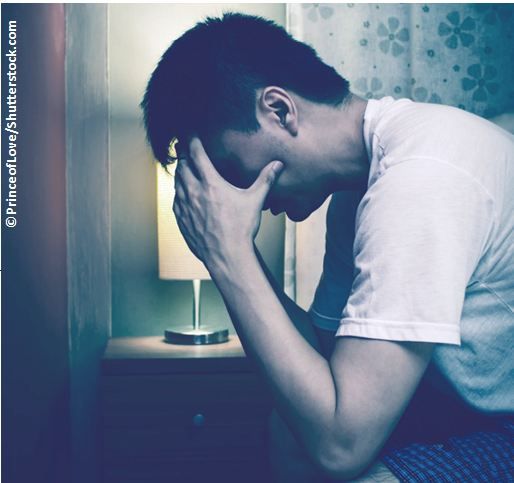- Clinical Technology
- Adult Immunization
- Hepatology
- Pediatric Immunization
- Screening
- Psychiatry
- Allergy
- Women's Health
- Cardiology
- Pediatrics
- Dermatology
- Endocrinology
- Pain Management
- Gastroenterology
- Infectious Disease
- Obesity Medicine
- Rheumatology
- Nephrology
- Neurology
- Pulmonology
Chronic Insomnia: 6 Questions for Primary Care
How much less sleep do insomniacs get? What causes brainstem hyperarousal? Is insomnia heritable? If you snooze, you lose on this quiz!
©PrinceofLove/Shutterstock.com

1. The American Psychiatric Association’s Diagnostic and Statistical Manual of Mental Disorders-5 (DSM-5) defines chronic insomnia as difficulty in falling asleep, staying asleep, and/or early morning awakening, accompanied by at least one daytime issue such as fatigue, attention problems, or mood instability that occurs at least 3 times per week and lasts for how many months?
A. 2
B. 3
C. 4
D. 6
Please click here for answer, discussion, and next question.
Answer: B. 3 months.
For a diagnosis of chronic insomnia to be made, the characteristic sleep difficulties must occur at least 3 times per week and last for 3 months.1 The DSM-5 removed classifications for primary secondary forms of insomnia in favor of a broader category that encompasses insomnia related to medical and psychiatric conditions.
2. Approximately what percentage of patients with traumatic brain injury (TBI) suffer from chronic insomnia?A. 20%-30%
B. 30%-50%
C. 30%-70%
D. 50%-70%
Please click here for answer, discussion, and next question.
Answer: C. 30%-70%
Chronic insomnia can be a symptom of underlying medical, neurologic, and psychiatric disorders. Approximately 30%-70% of people with TBI may suffer from insomnia.2 Difficulties can include trouble falling or staying asleep, which can exacerbate related pain, cognitive deficits, fatigue, or irritability. Insomnia has also been linked to cognitive impairment and may be a symptom of neurologic diseases, such as multiple sclerosis, Parkinson disease, Alzheimer disease, stroke, and epilepsy. The link between insomnia and depression is especially strong. Insomnia may also increase the risk for cardiovascular disease.3
3. People with insomnia sleep about (how many) fewer minutes per night than people without insomnia? A. 25
B. 60
C. 90
D. 120
Please click here for answer, discussion, and next question.
Answer: A. 25 minutes
A recent meta-analysis suggested that people with insomnia sleep about 25 minutes less per night than people with normal sleep patterns. People with insomnia may also spend less time in slow-wave and REM sleep than normal sleepers.4 Insomnia may be characterized by more frequent brief awakenings, microarousals, and fast EEG frequencies, indicating an imbalance in the sleep-wake switch.
4. Chronic insomnia may have a genetic component.A. True
B. False
Please click here for answer, discussion, and next question.
Answer: A. True
Family studies suggest that some components of chronic insomnia may be inherited. Roughly 35%-55% of first-degree relatives of people with insomnia may also suffer from the problem, a much higher rate than among relatives of people with normal sleep.1
5. Which of the following is/are probably involved in the hyperarousal that is characteristic of insomnia?A. Cortisol
B. Adenosine
C. GABA
D. All of the above
Please click here for answer, discussion, and next question.
Answer: D. All of the above.
The hyperarousal associated with insomnia may involve activation of the HPA axis, with cortisol as the major stress hormone involved. Adenosine is thought to promote sleep and can block the orexin system, which plays an important role in sleep regulation. Abnormalities in adenosine could lead to hypoactivity of the sleep-promoting areas of the brain. The inhibitory neurotransmitter GABA acts on cells in the brainstem and hypothalamus that promote arousal.
Common treatments for insomnia include cognitive-behavioral therapy (CBT), benzodiazepines, and benzodiazepine-receptor agonists.
6. What percentage of people with insomnia do not find relief with these approaches?A. 20%
B. 30%
C. 40%
D. 50%
Please click here for answer, discussion, and next question.
Answer: C. 40%
CBT, benzodiazepines, and benzodiazepine-receptor agonists (eg, alprazolam, clonazepam) have been used to treat insomnia for at least 3 decades, yet relief from these may elude approximately 40% of patients who use them.5 CBT, considered first-line therapy for insomnia, addresses sleep hygiene, control of stimuli, sleep restriction, relaxation, and cognitive techniques. Benzodiazepines and benzodiazepine-receptor agonists bind to the benzodiazepine receptor site on GABAergic neurons and increase inhibition of areas in the brainstem and hypothalamus that promote arousal and strengthen sleep drive. Efficacy of these medications can be curtailed by the rapid development of tolerance and risk for dependence.
References:
- American Psychiatric Association. Diagnostic and Statistical Manual of Mental Disorders, DSM-5. Washington, DC: American Psychiatric Association; 2013.
- Ouellet MC1, Savard J, Morin CM. Insomnia following traumatic brain injury: a review. Neurorehabil Neural Repair. 2004;18:187-198.
- Riemann D, Nissen C, Palagini L, et al. The neurobiology, investigation, and treatment of chronic insomnia.Lancet Neurol. 2015;14:547-558. doi:10.1016/S1474-4422(15)00021-6. Epub 2015 Apr 12.
- Baglioni C, Regen W, Teghen A, et al. Sleep changes in the disorder of insomnia: a meta-analysis of polysomnographic studies. Sleep Med Rev. 2014;18:195-213.
- Morin CM, Vallières A, Guay B, et al. Cognitive behavioral therapy, singly and combined with medication, for persistent insomnia: a randomized controlled trial.JAMA. 2009;301:2005-2015. doi:10.1001/jama.2009.682.
